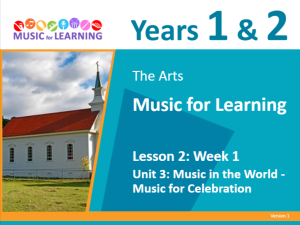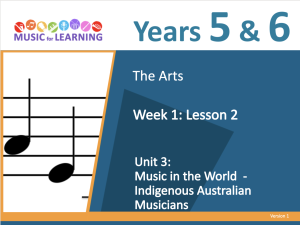Music for Learning Years F–6
Unit 3
Good to Great Schools Australia’s range of ready-to-teach lessons and resources in Music align to the Australian Curriculum. All lessons use explicit instruction pedagogy and content that cover Australian perspectives and learning outcomes. Lessons are formulated based on scientific evidence of how students best learn and are further informed by cognitive science.
Free Starter Lessons
Year Overview
Foundation Year – Music is All Around Me
Australian Curriculum Content Descriptions
Overview
Unit 3: Music in the World – Music is All Around Me – Foundation Year is a Music unit for Foundation Year students. It aligns to the Australian Curriculum Content Description:
- Explore how and why the arts are important for people and communities (AC9AMUFE01).
Learning Objectives
In weeks 1-10, students learn:
- that music is a special kind of sound that is used for singing, playing and dancing together
- that making music is for everyone
- that there are many cultures all around the world
- that every culture has its own musical traditions
- it is okay to feel many different emotions while listening to or playing music
- that music can help us express our emotions, share emotions and manage difficult feelings
- that music happens in every house
- that every house has different music in it and is an expression of a family’s culture and choices
- that every community has its own musical tradition
- that music reflects community values and expresses these to each other and the world
- that music is important to celebrations
- examples of where music is used to celebrate parts of their own lives
- that music is used to teach and learn – for example, in learning the alphabet and remembering important facts
- examples of songs that teach us things
- that music is used to teach and learn health messages, like washing hands
- a song about hand-washing
- that they are born with the capacity to make and enjoy music
- about the ways they might enjoy music throughout their own lives, in school and beyond
- to sing the song Obwisana
- to move and clap to the song Obwisana
- to sing Charlie Over the Ocean
- to play percussion to Charlie Over the Ocean
- to sing Charlie Over the Ocean as a round.
Success Criteria
- Explain how music can be used for singing, playing and dancing.
- Explain that every culture has its own musical traditions.
- Sing, play and dance along with songs from different cultures.
- Sing and play songs with different emotions.
- Explain how a song makes you feel happy, sad, scared or excited.
- Express an emotion through dancing to music.
- Talk about the music played and listened to in their house.
- Talk about who listens to and plays different music in their house.
- Say what music you like to play and listen to in their house.
- Provide examples of music in their community and how it expresses their culture.
- Talk about the music in their community that helps them to celebrate.
- Explain how songs have messages.
- List an example of a song that can be used for learning.
- Sing a song used for learning.
- Talk about and learn to sing songs that have healthy messages.
- Talk about and share some music they like and music they have made.
- Sing, move and clap to four songs.
- Sing and play untuned percussion with a song.
- Sing a simple call and response song together.
Assessment
Continuous Assessments
Continuous assessments are used to ascertain if the knowledge recently taught has been understood by the student. These include oral tasks administered to individual students or written tasks administered to the whole class for an entire lesson. Written tasks are completed in the Student Workbook.
Progress Test
A progress test in week five is used to assess whether the knowledge over the past half a term or five weeks has been mastered and retained by the student.
End-of-Unit Assessment
The end-of-unit assessment occurs at the end of the unit in week ten and consists of a series of marked questions to assess understanding of the material taught in the previous ten weeks and provides an opportunity for students to demonstrate their understanding of the unit. Teachers assess students’ work using a Guide to Making Judgements (GTMJ).
Year 1 and 2 – Music for Celebration
Australian Curriculum Content Descriptions
Overview
Unit 3: Music in the World – Music for Celebration – Years 1 and 2 is a music unit for Year 1 and 2 students.
It aligns to the Australian Curriculum Content Description:
- Explore where, why and how people across cultures, communities and/or other contexts experience music (AC9AMU2E01).
Learning Objectives
In weeks 1–10, students learn:
- that every culture in the world has different celebrations and music traditions
- that people around the world have different ways of celebrating birthdays with music
- some birthday music traditions from Australia and around the world
- that different cultures have different religious celebrations
- some religious songs from different traditions and the meaning behind them
- that people all around the world have weddings
- that people all around the world sing and play different wedding songs
- to sing and listen to some wedding songs
- that people all around the world listen to songs of mourning
- that people all around the world sing and play different songs of mourning
- to sing and listen to some songs of mourning
- that different cultures have different ways of celebrating and noting changes in the seasons
- that there are songs for harvests, seasons and other cycles
- to sing some songs about cycles and seasons
- that different cultures have different ways of celebrating national identity or community identity through singing anthems
- some national anthems from different peoples and the meaning behind them
- that they were born to make music.
Success Criteria
- Explain why we use music to celebrate special occasions.
- List some occasions where you use music to celebrate.
- Describe different ways that people celebrate birthdays, using music and dancing.
- Describe different ways that people celebrate using songs of praise and faith.
- Sing, play and listen to some songs of faith.
- Describe different ways people celebrate weddings around the world.
- Sing and listen to some wedding songs.
- Explain ways that some cultures use music to cope with death and change.
- Describe some features of songs of mourning and loss from different cultures.
- Explain ways that some cultures use music to mark out seasons and cycles.
- Sing some songs about seasons.
- Explain what a national anthem is and what it is for.
- Sing parts of some national anthems with confidence.
- Talk about music you like and why.
- Clap along to a celebratory song.
Assessment
Continuous Assessments
Continuous assessments are used to ascertain if the knowledge recently taught has been understood by the student. These include oral tasks administered to individual students or written tasks administered to the whole class for an entire lesson. Written tasks are completed in the Student Workbook.
Progress Test
A progress test in week five is used to assess whether the knowledge over the past half a term or five weeks has been mastered and retained by the student.
Final Assessment
Final assessment occurs at the end of the unit in week ten and consists of a series of marked questions to assess understanding of the material taught in the previous ten weeks and provides an opportunity for students to demonstrate their understanding of the unit. Teachers assess students’ work using a Guide to Making Judgements (GTMJ).
Year 3 and 4 – Instruments of the World
Australian Curriculum Content Descriptions
Unit 3: Music in the World – Instruments of the World – Years 3 and 4 is a Music unit for Year 3 and 4 students. It aligns to the Australian curriculum content descriptions:
- explore where, why and how music is composed and/or performed across cultures, times, places and/or other contexts (AC9AMU4E01)
- explore how First Nations Australians use music to communicate their connection to and responsibility for Country/Place (AC9AMU4E02)
Learning Objectives
In weeks 1-10, students learn:
-
- that every culture in the world has its own music tradition (Week 1)
- that every musical tradition has its own instruments, styles and dances (Week 1)
- how the elements of music are used differently around the world (week 1)
- to describe the music of the Pacific Islands, Indigenous Australia, Africa, Asia, Europe and South America using elements of music (Weeks 2-8)
- the purpose of some music from the Pacific Islands, Indigenous Australia, Africa, Asia, Europe and South America (Week 2-8)
- the sounds, names and uses of instruments from the Pacific Islands, Indigenous Australia, Africa, Asia, Europe and South America. (Week 2-8)
- to create an instrument using recycled materials.
Success Criteria
- use the elements of music to describe the music from different cultures (Week 1)
- identify and name traditional musical instruments and musicians from the Pacific Islands, Indigenous Australia, Africa, Asia, Europe and South America (Weeks 2-8)
- name and explain three elements of music of the Pacific Islands, Indigenous Australia, Africa, Asia, Europe and South America. (Weeks 2-8)
Assessment
Continuous assessments
Continuous assessments are used to ascertain if the knowledge recently taught has been understood by the student. These include oral tasks administered to individual students or written tasks administered to the whole class for an entire lesson. Written tasks are completed in the Student Workbook.
Progressive tests
A progressive test in week five is used to assess whether the knowledge over the past half a term or five weeks has been mastered and retained by the student.
Final assessment
Final assessment occurs at the end of the unit in week ten and consists of a series of marked questions to assess understanding of the material taught in the previous ten weeks and provides an opportunity for students to demonstrate their understanding of the unit.
Teachers assess students’ work using a Guide to Making Judgements (GTMJ).
Year 5 and 6 – Indigenous Australian Musicians
Australian Curriculum Content Descriptions
Overview
Unit 3: Music in the World – Indigenous Australian Musicians Year 5 and 6 is a Music unit for Year 5 and 6 students. It aligns to the Australian Curriculum Content Descriptions:
- Explore where, why and how music is composed and/or performed across cultures, times, places and/or other contexts (AC9AMU4E01).
- Explore how First Nations Australians use music to communicate their connection to and responsibility for Country/Place (AC9AMU4E02).
Learning Objectives
In weeks 1–10 students learn:
- to perform music such as unison songs, rounds and instrumental music arranged for small ensembles that feature melody and accompaniment parts such as ostinato or drones
- to introduce performances by sharing information such as the intended purposes of their compositions with others and documenting how they used the elements of music when composing and performing
- to rehearse and perform music using a range of technologies; for example, learning and (with assistance) applying techniques for using sound reinforcement equipment, planning how they will stage a performance and introducing their performances to audiences using spoken, written or audio-visual formats
- to read from notation and/or documentation such as a lead sheet (lyrics and chords), staff or graphic notation that includes invented or learnt symbols when practising and performing music.
Success Criteria
- Singing and playing learnt pitch and rhythm patterns and varying elements of music within them to create different effects; for example, singing softer or louder, faster or slower, repeating phrases, extending or shortening rhythmic values.
- Listening to the effects they create by manipulating elements of music in different ways and discussing how easy/difficult different choices are to perform accurately, asking questions such as ‘What works and why?’ (Noting that there may be a range or responses across the class.)
- Listening to diverse examples of music to explore how rhythm and pitch patterns, structures or timbres are used; for example, listening to identify whether a rhythmic or melodic pattern is repeated in every bar/measure or used only in a specific section such as verse or chorus.
- Practising reading staff, graphic and/or invented notation as they rehearse and perform.
- Exploring options for representing sounds in a score; for example, inventing a graphic score to represent sounds of the environment or using a combination of staff notation and invented symbols, then using the score when rehearsing and making changes to ensure it is accurate and useful/easy to follow in performance.
Assessment
Continuous Assessments
Continuous assessments are used to ascertain if the knowledge recently taught has been understood by the student. These include oral tasks administered to individual students or written tasks administered to the whole class for an entire lesson. Written tasks are completed in the Student Workbook.
Progress Test
A progress test in week five is used to assess whether the knowledge over the past half a term or five weeks has been mastered and retained by the student.
Final Assessment
Final assessment occurs at the end of the unit in week ten and consists of a series of marked questions to assess understanding of the material taught in the previous ten weeks and provides an opportunity for students to demonstrate their understanding of the unit. Teachers assess students’ work using a Guide to Making Judgements (GTMJ)








